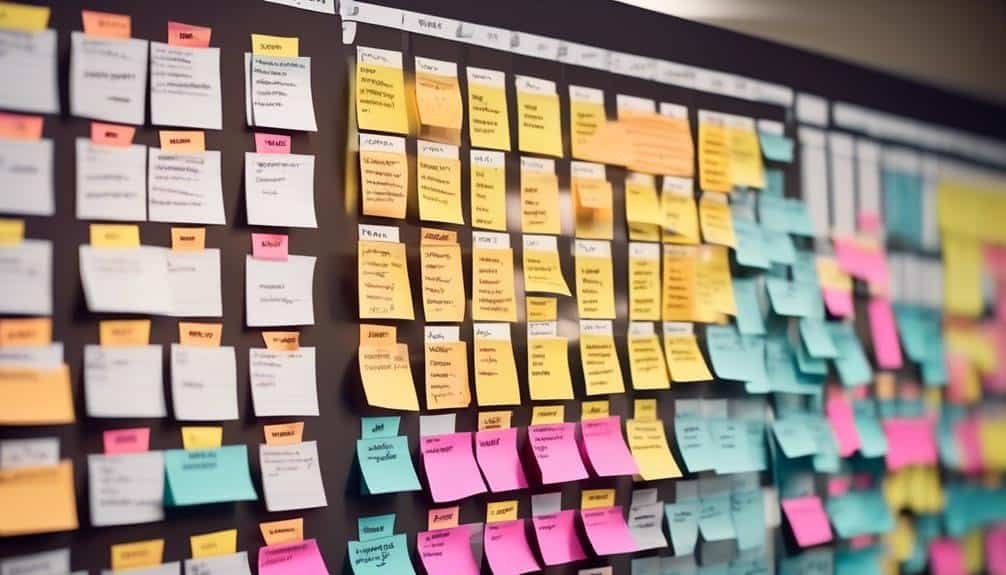Kanban Boards: Enhancing Workflow and Productivity
In today's fast-paced and ever-evolving work environment, finding effective ways to enhance workflow and productivity is crucial.
Enter Kanban boards, a powerful tool that has gained popularity across industries. But what exactly is Kanban and how can it revolutionize the way you work?
In this discussion, we will explore the principles behind Kanban methodology, examine the benefits of implementing Kanban boards in your workflow, and uncover the ways in which it can streamline processes, enhance team collaboration, and ultimately maximize productivity.
So, if you're looking for a game-changing approach to managing tasks and projects, buckle up and prepare to discover the transformative potential of Kanban boards.
Key Takeaways
- Kanban boards provide a clear and visual representation of the workflow.
- Limiting work in progress (WIP) helps prevent overloading and multitasking.
- Kanban boards streamline processes and improve overall efficiency.
- Kanban boards enhance collaboration, transparency, and communication within teams.
Understanding Kanban Methodology
The Kanban methodology is a highly effective and organized approach to visualizing and managing workflow in order to enhance productivity and efficiency. Adopting the Kanban methodology offers numerous benefits.
Firstly, it provides a clear and visual representation of the workflow, allowing teams to easily identify bottlenecks and areas for improvement. By visualizing the entire process, teams can better understand the flow of work and make informed decisions on how to optimize it.
Secondly, Kanban promotes a pull-based system, meaning work is only pulled into the workflow when capacity allows, preventing overloading and reducing the likelihood of delays or downtime.
Implementing the Kanban methodology involves several key principles.
The first is visualizing the workflow using a Kanban board, which typically consists of columns representing different stages of work, and cards representing individual tasks. This visual representation allows teams to track progress and identify any impediments.
The second principle is limiting work in progress (WIP), which helps prevent multitasking and ensures that resources are allocated effectively. By setting WIP limits, teams can focus on completing tasks before starting new ones, resulting in increased efficiency and faster cycle times.
Implementing Kanban Boards in Your Workflow
To effectively incorporate Kanban boards into your workflow, it is essential to establish a clear and streamlined process that enhances visibility and facilitates efficient task management. Implementing Kanban boards can greatly improve efficiency and productivity by visualizing tasks and providing a visual representation of the workflow.
Here are three key steps to successfully implement Kanban boards in your workflow:
- Define your workflow: Start by identifying the different stages and steps involved in your workflow. This could include steps like 'To Do,' 'In Progress,' and 'Completed.' Clearly define the criteria that determine when a task moves from one stage to another.
- Create your Kanban board: Set up a physical or digital Kanban board that represents your workflow stages. Use columns or swimlanes to represent each stage, and use cards or sticky notes to represent individual tasks. This visual representation allows you to easily see the status of each task and identify any bottlenecks or delays.
- Set work-in-progress limits: One of the key principles of Kanban is limiting the number of tasks that can be worked on simultaneously. By setting work-in-progress limits for each stage, you can prevent overloading and ensure that tasks are completed in a timely manner. This helps to improve efficiency and reduce multitasking.
Streamlining Processes With Kanban Boards
Implementing Kanban boards in your workflow can significantly streamline processes and improve overall efficiency.
Kanban boards provide a visual task management system that allows teams to easily track and prioritize work. By visualizing the workflow and identifying bottlenecks, teams can identify areas for improvement and take action to optimize their processes.
A Kanban board typically consists of three columns: 'To-Do,' 'In Progress,' and 'Done.' Each column represents a different stage of work, and tasks are moved across the board as they progress. This simple, visual representation of tasks allows team members to quickly grasp the status of each item and make informed decisions about what to work on next.
By using Kanban boards, teams can improve efficiency in several ways.
Firstly, the visual nature of the boards ensures that everyone has a clear understanding of the work in progress, reducing confusion and miscommunication.
Secondly, the ability to prioritize tasks and manage work in progress helps teams focus on the most important and urgent tasks, avoiding overload and increasing productivity.
Lastly, the continuous improvement aspect of Kanban encourages teams to regularly assess and refine their processes, leading to ongoing efficiency gains.
Enhancing Team Collaboration With Kanban
Building upon the foundation of streamlining processes with Kanban boards, teams can further enhance their collaboration and productivity through effective utilization of this visual task management system.
Kanban boards provide a visual representation of tasks, making it easier for team members to understand what needs to be done, who is responsible for each task, and the overall progress of the project.
By implementing Kanban, teams can improve communication and increase efficiency in the following ways:
- Real-time updates: Kanban boards allow team members to see the status of each task in real-time. This promotes transparency and facilitates better communication, as team members can easily identify bottlenecks and address them promptly.
- Clear task assignments: Kanban boards enable teams to assign tasks to specific team members, ensuring accountability and clarity. This reduces confusion and increases efficiency, as team members know exactly what they need to work on and can prioritize their tasks accordingly.
- Collaborative problem-solving: Kanban boards encourage collaboration by providing a platform for team members to discuss and resolve issues. As tasks progress through the workflow, team members can leave comments, ask questions, and provide updates, fostering a collaborative environment where problems can be identified and resolved quickly.
Maximizing Productivity With Kanban Boards
Maximizing productivity is a key objective when utilizing Kanban boards for task management. Kanban boards are effective tools that help teams visualize their workflow and streamline their processes. By implementing Kanban boards, teams can increase efficiency and achieve effective task management.
One way to maximize productivity with Kanban boards is by setting clear priorities and deadlines for tasks. By assigning due dates and priorities to each task on the board, team members are able to focus on completing the most important tasks first. This helps to prevent bottlenecks and ensures that work is continuously flowing.
Another way to increase productivity is by limiting work in progress (WIP). Kanban boards allow teams to set a maximum limit on the number of tasks that can be in progress at any given time. By doing so, teams can avoid overloading themselves and maintain a steady pace of work. This prevents multitasking and allows team members to fully concentrate on completing one task at a time.
Additionally, Kanban boards provide transparency and visibility into the status of tasks. Team members can easily see the progress of each task, who is responsible for it, and any potential blockers. This enables effective communication and collaboration, ensuring that any issues or challenges are addressed promptly.
Conclusion
In conclusion, implementing Kanban boards in your workflow can greatly enhance productivity and streamline processes. By visualizing tasks and their progress, teams can easily identify bottlenecks and prioritize work effectively.
This methodology also promotes collaboration and communication among team members, leading to improved efficiency and outcomes.
Just like a well-orchestrated symphony, Kanban boards harmonize the efforts of individuals and create a synchronized workflow that produces beautiful results.







